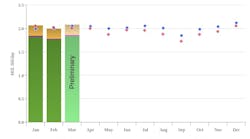Research Partnership to Secure Energy for America (RPSEA), Sugar Land, Tex., has sought responses by Dec. 18 to its October release of the remaining four 2011 ultradeepwater program request for proposals to award $14 million in oil and natural gas research and development projects offshore.
The projects selected under the 2011 ultradeepwater program will safely develop the US ultradeepwater resource base while efficiently extracting the natural gas and oil needed to meet the nation's energy needs. The goal is to ensure that control, safeguard, and environmental impact mitigation strategies are adequate to prevent environmental damage associated with oil and gas development.
The 2012 RFPs are under review and will follow the release of 2011. The program was established by the US Department of Energy. The RFPs just issued cover four technical areas of interest.
The objective of the RFP titled carbon-fiber reinforced riser for dry tree drilling of high pressure wells is to develop a carbon-fiber reinforced riser for dry tree Gulf of Mexico drilling by expanding on the results from an earlier RPSEA project. It involves designing several full-scale riser samples, deploying and testing them in a deepwater environment, and retrieving them for more tests as part of a field tested-field ready qualification process.
The objective of the RFP called integrity management of risers to support deepwater drilling and production operations is to develop a reliable, cost-effective system for real-time riser integrity management that enables end users to remotely monitor the health and performance of deepwater riser systems and improve their long-term integrity management and reliability.
The objective of vortex induced vibration study for deep draft column stabilized floaters is to conduct a study and model test to determine the sensitivity of the vortex induced motion response to the geometric parameters of deep draft semisubmersibles. This also follows an earlier RPSEA project.
The objective of the RFP known as hi-res environmental data for enhanced ultradeepwater operations safety is to accurately measure bottom currents, currents during a joint hurricane-eddy, and surface currents, real-time, and develop reliable and repeatable models to enable more reliable and safer design of pipelines, flexible flow lines, and floating vessels, and to improve forecasting of currents (and potentially releases) in large loss of well control situations.
Organizations, which must have a US-based business, are encouraged to submit proposals well in advance of the due date to allow for electronic receipt processing and should review the documents and instructions concerning these proposals on RPSEA's web site.
